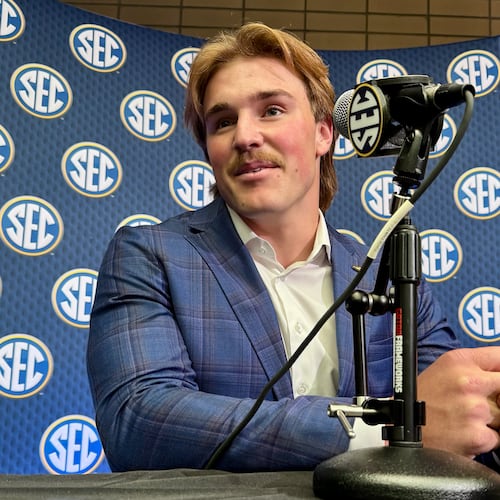Editor’s note: The Atlanta Journal-Constitution is presenting a series of columns from our staff detailing the five most memorable games they have covered in their careers.
A person finds a job – or it finds him – in which he produces nothing of tangible value nor even estimable worth. And from such a job an absurd career is made of writing about people and the games they play.
On occasion, the very best times in a sportswriter’s work life, that career takes him to events that surprise and amaze and, in many ways, flesh what it is to be human. To have the privilege of folding such special moments into your own experience, that is the payoff of 40 years doing this. Some of those memories are painful, some wry, others ridiculous. All of them are treasured.
Take all the games away, like now, and that only makes these events more cherished.
Here are five personal favorites, and that’s not even counting when Boston College’s Doug Flutie heaved one deep to Gerard Phelan at the Orange Bowl (1984) or when spilled coffee froze on the pressbox floor during the second-coldest-ever NFL game (San Diego at Cincinnati, 1982) or when Dan Reeves danced the Dirty Bird in the NFC Championship in Minneapolis (1999).
No. 5, August 3, 1992. An Olympic Sampler.
The stories that come with having been to nine Olympics (five summer, four winter) are the ultimate variety pack. I’ve written about an embarrassing number of sports I know nothing about in countries where I understood little of what was spoken.
In Barcelona, I had this idea to go wandering one day. As ideas go, it went a little better than the time I wanted to see what would happen if I walked up to the front desk at the Augusta National clubhouse during a long-ago Masters and asked for a membership application.
On a very warm day, Celsius, I tried to experience as many of the obscure events as possible around town, and in the course of that, get a feel for this wonderful host city. And if that meant having to walk through a tops-optional beach to get to the yachting venue, then I would brave it.
None of the events – let’s see, team dressage, table tennis, badminton, yachting, archery, judo or fencing – were remarkable. Plenty of press seating was available.
It was the in between that sticks with me, one little slice-of-life episode that still makes me smile.
His name was Jorge. Maybe 10 years old, he was shooting baskets on a small, out-of-the-way court. I had played pick-up in Calgary during the 1988 Winter Games, and even beaten a pair of Samoan wrestlers in Seoul in some two-on-two that same year. So, naturally I stopped and asked the kid if I could shoot with him.
In one little exchange, the enormity of the NBA’s decision to join these Olympics and what it would mean to its global reach became clear at the street level. Mind you, this was right after a team headed by Michael Jordan, Magic Johnson and Larry Bird had beaten a small African nation by 68 points.
Jorge waved me onto the court and knew just enough English to say:
“Me, Dream Team.
“You, Angola.”
After I stopped laughing, I crushed the kid. Because that’s the American way.
No. 4, Oct. 17, 1989. PPD, Earthquake.
Even 31 years ago, San Francisco’s Candlestick Park was kind of a dump. But I swore to never deride it again after the late afternoon it held up when many other structures nearby didn’t.
Shortly after 5 p.m. before the start of Game 3 of the Bay Area World Series between San Francisco and Oakland, those of us in the upper deck auxiliary press area first picked up the sound of a low rumble. Then the concrete beneath our feet began to shiver. The light towers swayed like prairie wheat.
The quake lasted for seconds but seemed like minutes. Thank heavens I was in the company of a savvy amateur seismologist, former workmate Jeff Schultz who had just moved to the AJC from northern California. He assured me this was likely no more than a 3 or 4 on Richter Scale. I’ve been hesitant to believe anything he has said since.
It actually was a 6.9 tremblor that would collapse a double deck section of the Nimitz Freeway, touch off fires in the Marina District and cause building collapses throughout the area. The death toll was put at 63. God bless Candlestick Park, intact through it all.
With the damage not yet clear, the immediate need was to write the scene at hand, as players milled with their families on the field afterward. The game would be postponed and played 10 days later.
The power was temporarily out and darkness was falling. I typed part of the story in a stadium hallway beneath an emergency light. The next day, we’d be pressed into duty reporting from the scene of the collapsed freeway. Late on the night of the earthquake, though, there were two immediate priorities: Finding a working phone line to transmit the story and then finding a bar that was open. Mission accomplished on both fronts.
Coincidence or not, I began turning gray not long after that series.
No. 3, Feb. 18, 2001. Dale Earnhardt dies at Daytona.
What a frantic finish the 2001 Daytona 500 provided. Looked to be one of the best ever, as on the final turn Dale Earnhardt Jr. was trying to run down teammate Michael Waltrip. Right behind was Earnhardt’s father, the legendary one, the winner of seven series championships.
As the elder Earnhardt tried to make his move, he was tapped in the rear quarter panel by Sterling Marlin and veered headlong into the outer wall. With the crash behind them, Waltrip finished ahead of Earnhardt Jr. by .12 of a second. There had been a hundred crashes that looked worse and everyone walked away. No reason to harbor dire thoughts about this one.
But then I caught sight of Darrell Waltrip leaving the broadcast booth looking drawn and glum.
Then, before removing the wreckage from the track, workers covered Earnhardt’s car in a tarp, as sure an indicator of tragedy as any shroud.
I would be touched by other wrenching events on the track – it was after I covered Barbaro breaking down at the start of the 2006 Preakness that the late AJC columnist Furman Bisher gave the worst piece of advice he ever offered me: “You should have written more about the winner.” But this – the death of the greatest driver of his time playing out in the biggest race of them all – made you almost too numb to type.
The pall over the track, and over the sport, was almost impenetrable. Later that night, I’d talk to excavators and sheet metal workers, hard men camped in the infield who were bawling without shame. The next day, down I-4 at the Braves spring camp, then coach Ned Yost, an Earnhardt buddy, was just as shredded by the news.
I don’t know that racing has ever fully recovered.
No. 2, June 28, 1997. Tyson snacks on Holyfield.
A little secret of the trade: On really late events – like major fights in Las Vegas – where deadlines are oppressive, we try to get a little head start. Beforehand, we’ll type in some background words that will stand up regardless of the outcome. Then you slap on a quick top, send the piece on its way and then go searching for an open restaurant.
Oh, so cleverly, I had prepared for the Holyfield-Tyson rematch, sketching out two separate columns, one in the event of a victory by Atlanta’s heavyweight champ, one in the event of a loss.
But I forgot to prepare one in case Tyson went temporarily, cannibalistically insane and bit off a piece of Holyfield’s ear.
The really weird just seemed to follow Holyfield – like the fellow in a motorized paraglider flying into the ring ropes during one of his bouts against Riddick Bowe. I should have known it was only a matter of time before someone tried to eat him.
Blinded by frustration, Tyson not once, but twice bit Holyfield in the third round. The first one took a notch from the top of Holyfield’s right ear, the piece of which Tyson spat to the ring. Disqualified after the second bite, he didn’t get a chance at a third course. All bedlam broke out in the ring (and would carry on later during a panicked, gaming-tables-go-flying scene at the MGM Grand Casino).
OK, bucko, write something witty about what would come to be known as “The Bite of the Century” in the next 30 minutes. Sorry, time’s up. You gotta file what you have.
By the next afternoon, Holyfield was still seeping blood from the wound. Known as “The Real Deal,” he at least supplied a little help for the second-day story. “I'm The Real Meal now,” he said.
No. 1, April 13, 1986. Olden Bear wins Masters.
You look back on stories like this with a mixture of fondness and regret. Fondness, of course, for just being there to witness something you know will be burned into the chronicles of a sport (even if it was impossible to get a good view that day through the building mob). Regret that you didn’t do better when it came time to scribe, that your words were wholly inadequate. But then, most words were.
The great Nicklaus had arrived at the ’86 Masters winless since May, 1984. His playing schedule was light and even lighter on encouragement. In his seven PGA Tour events that year leading up to the Masters, Nicklaus had missed three cuts, withdrawn once and enjoyed no finish higher than 39th. No wonder that in his tournament preview the AJC’s Tom McCollister wrote, “Nicklaus is gone, done. He just doesn’t have the game anymore. It’s rusted from lack of use. He’s 46, and nobody that old wins the Masters.”
Not even in the conversation until the back nine on Sunday, Nicklaus won by ambush. He just kept making shots – committing six birdies and an eagle on his closing 10 holes – while others around him bowed and backed away. Good ol’ Greg Norman was the final accomplice to the story, blowing his routine approach to No. 18 into the crowd and falling out of a tie for the lead with a bogey.
I know how Norman felt. The moment was too big for me, too. I’m still not happy with what I wrote that day for the Fort Lauderdale Sun-Sentinel. But damn glad I had the chance to be there for the deafening last hurrah of the greatest golfer ever.
Nothing will ever better that one. Here’s hoping we get back soon to the search for the next best thing.
About the Author
Keep Reading
The Latest
Featured



